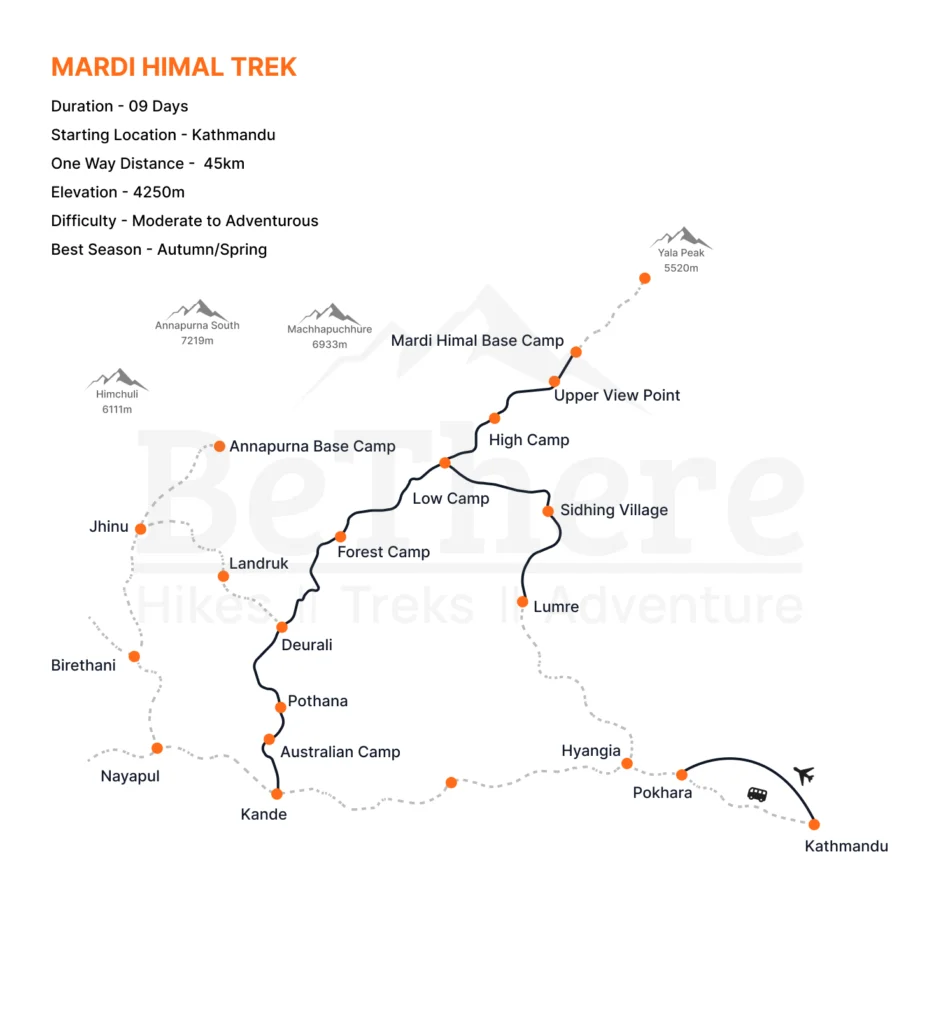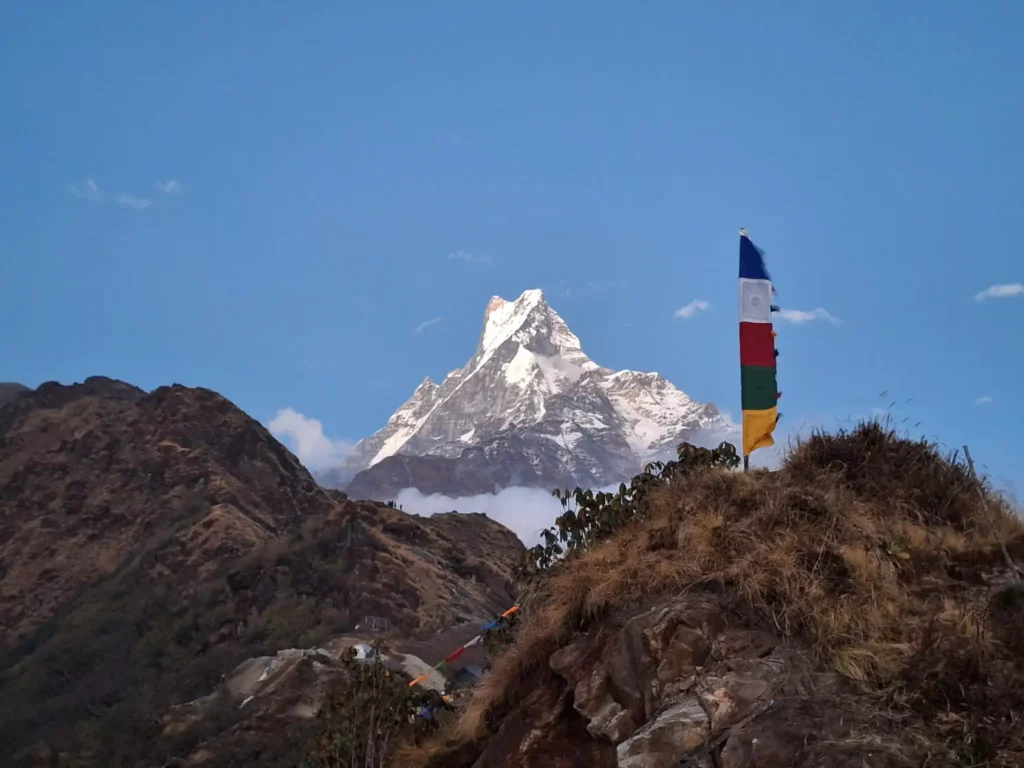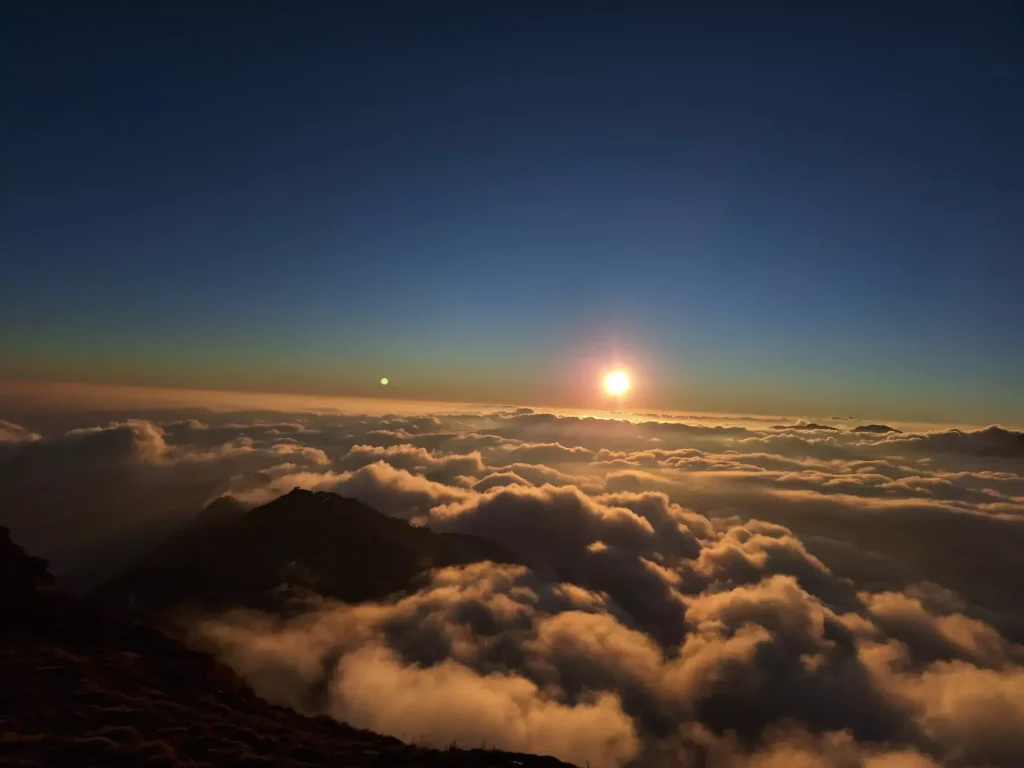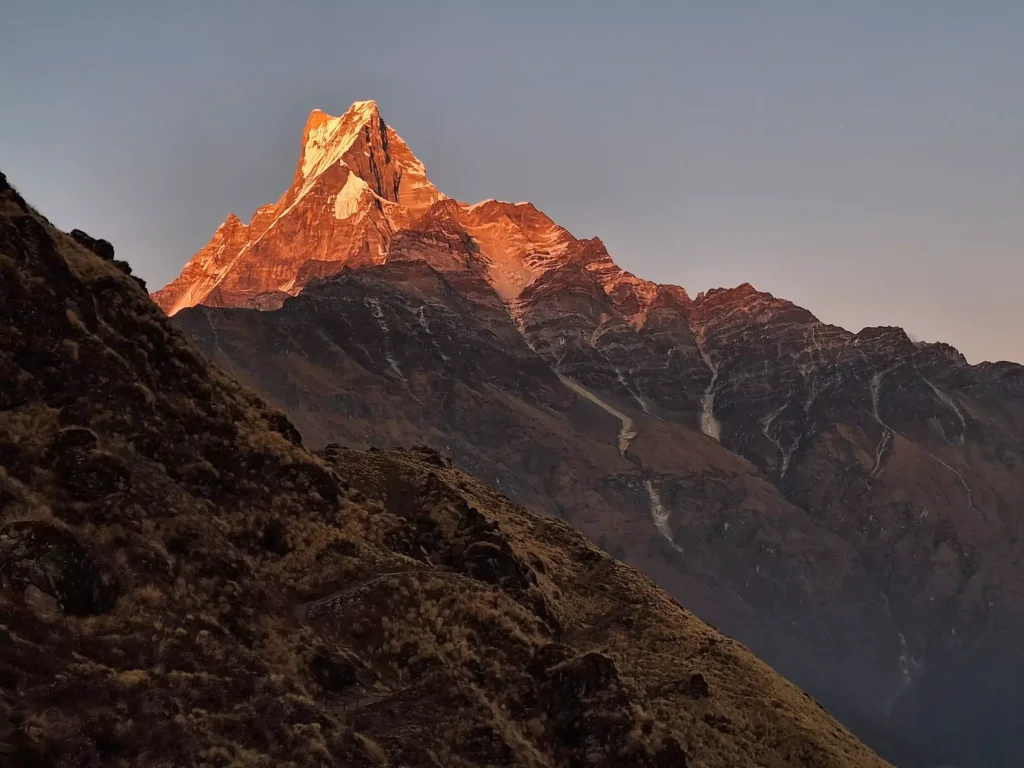Mardi Himal Trek
- Annapurna Conservation Area, Nepal - Show on map
- 8 Days
Duration
8 Days
Max. Altitude
4250m
Difficulty Level
Moderate
One Way Distance
45Km
Start/End Point
Kathmandu
Best Season
Autumn/Spring
Duration
8 Days
Max. Altitude
4250m
Difficulty Level
Moderate
One Way Distance
45Km
Start/End Point
Kathmandu
Best Season
Autumn/Spring
Overview
The Mardi Himal Trek is one of the most scenic short treks in Nepal. It takes you through the heart of the Annapurna region without requiring a long time commitment. It’s perfect for those who want to experience the Himalayas without taking on a high-altitude expedition. Though less known than its neighboring trails like Annapurna Base Camp or Poon Hill, Mardi Himal offers a unique experience filled with diverse landscapes, panoramic mountain views, and authentic village life.
The Mardi trek was officially opened to the public around 2012. Since then, it has quietly gained popularity among trekkers looking for a more peaceful route. The trail starts in the lower hills of Kaski District, Kande and gradually ascends through beautiful rhododendron forests and traditional villages to High Camp. From there, you reach Mardi View Point near Mardi Himal Base Camp at an altitude of around 4,250 meters, from where you’ll get dramatic views of Machapuchhre (Fishtail), Annapurna South, and Hiunchuli.
What makes Mardi Himal special is its balance between accessibility and adventure. The trek is moderate in difficulty and suitable for both first-time hikers and experienced adventurers. The journey is short but rewarding, packed with diverse landscapes, mountain panoramas, and rich cultural experiences, making it ideal for those with limited travel days.
Highlights of Mardi Himal Trek
- Panoramic views of Annapurna South, Hiunchuli, and Machapuchhre
- Peaceful trails through dense rhododendron and oak forests
- Sunrise from Mardi View Point with golden Himalayan peaks
- Warm hospitality in traditional Gurung and Magar villages
- Teahouse accommodation with hearty local meals
- A less-crowded alternative to popular Annapurna region treks
- Ideal for both beginners and experienced trekkers
Mardi Himal Trek Itinerary
Day 01Arrival In Kathmandu
Upon landing at Tribhuvan International Airport, you will be welcomed by the vibrant energy of Kathmandu. The streets of Kathmandu are full of life, colour, and history. From temples to bustling markets, this city offers a mix of old and new vibes.
You will be transferred to your hotel, where you can rest after your journey. You can use this day to rest and prepare for the adventure ahead. If you arrive early, consider exploring the colourful streets of Thamel, visiting nearby temples, or enjoying a local meal. This day is all about settling in and getting ready for the days ahead.
Day 02Fly to Pokhara And Drive to Kade (1,770m/5,807ft), Trek To Australian Camp (2,060m/6,759ft)
After breakfast, you take an early flight to Pokhara, Nepal’s beautiful lake city. From Pokhara, a private vehicle takes you to Kande, where the trek begins. The trail winds uphill through peaceful forests and small settlements. After about 2 to 3 hours of walking, you reach Australian Camp. This spot offers stunning views of the Annapurna range and Machapuchhre. It’s a great place to acclimatize. You spend your first night here in the mountains, enjoying the crisp air and peaceful environment.
Day 03Trek to Forest Camp (2,550m/8,366ft)
Your journey today continues through dense rhododendron and oak forests. The trail is serene with the sound of birds and fresh mountain air. The path is not too steep but offers a steady climb, giving your legs a good workout. There are fewer settlements along the way, so it feels like you’re walking through untouched nature. By afternoon, you arrive at Forest Camp. Forest Camp is a peaceful resting point surrounded by trees, where you will enjoy a warm meal and have a good night’s rest.
Day 04Trek to High Camp (3,550m/11,647ft)
As you ascend from Forest Camp, you start to leave the dense forest behind. The trail moves upward toward Low Camp and the views open up. You pass Low Camp and continue along a ridge that offers stunning views of Machapuchhre and Mardi Himal. The air becomes cooler and thinner, so it’s important to walk slowly and stay hydrated. Reaching High Camp is a rewarding moment. The teahouses here are basic, but the surroundings are unmatched. With clear skies, you’ll be treated to a spectacular night sky filled with stars.
Day 05Trek to Mardi View Point (4,250m/13,943ft) and Back to Low Camp (2,970m/9,744ft)
Today is the highlight of the Mardi trek. You wake up early, usually before dawn, and begin the hike to Mardi View Point. The trail is steep and rocky, and you may also feel the effects of high altitude, but the reward is incredible. As the sun rises, the peaks turn golden and the whole Annapurna range lights up before your eyes. After spending time at the viewpoint, you return to High Camp for breakfast, then descend to Low Camp for the night. It’s a long but unforgettable day.
Day 06Trek to Sidhing (1,750m/5,741ft) and Drive to Pokhara
Today, you descend steadily through forests and meadows from Low Camp. The trail is quieter and passes through small villages where you can witness the local way of life. You reach Sidhing by midday. Here, a jeep will be waiting to take you back to Pokhara. Once you arrive in the city, you can enjoy the comforts of city life again. A hot shower, a nice meal, and a walk around the lakeside make a perfect end to your trekking journey.
Day 07Fly To Kathmandu
After breakfast in Pokhara, you catch a short flight back to Kathmandu. You can spend the rest of the day exploring the city, shopping for souvenirs, or simply resting. This marks the end of your Mardi Himal Trek. You leave with unforgettable memories, beautiful photos, and a deep connection to the mountains.
Day 08Departure from Kathmandu
Your Mardi Himal Trek ends today. Our team will transfer you to the airport based on your flight schedule. You leave Nepal with lifelong memories of a journey filled with mountains, culture, holy lakes, and adventure.

Cost Includes and Excludes
- Airport pick-up and drop-off
- Domestic flights between Kathmandu and Pokhara (round trip)
- All ground transportation related to the trek
- Twin-sharing accommodation in Kathmandu and Pokhara
- Teahouse lodging during the trek
- All meals during the trek (breakfast, lunch, and dinner)
- Professional, licensed trekking guide and porter
- TIMS Card and Annapurna Conservation Area Permit (ACAP)
- First aid kit, trekking map, and necessary paperwork
- Emergency support and communication equipment
- International flights and Nepal visa fees
- Meals in Kathmandu and Pokhara (except breakfast)
- Extra nights due to early return or bad weather
- Personal expenses (wifi, laundry, hot showers, etc.)
- Travel and rescue insurance
- Tips for the guide and the porter
- Any services not mentioned in the inclusions
Gear Checklist for Mardi Trek
Item
Quantity
Four-season (zero-degree) sleeping bag
1
Puffy down jacket
1
Daypack (35–45 liters recommended) with rain cover
1
Sleeping bag liner
1
Sun hat or cap
1
Knitted hat
1
Headlamp
1
Sunglasses
1
Technical fabric base layer (upper body)
1
Technical fabric short-sleeve shirts
2
Technical fabric long-sleeve shirts
2
Waterproof, windproof shell (jacket)
1
Fleece jacket or pullover
1
Technical fabric base layer (lower body)
1
Hiking pants
2
Comfortable pants for inside teahouses
1
Waterproof, windproof shell (pants)
1
Hiking shorts
1
Wool or technical fabric liner gloves
1 pair
Hard-shell outer gloves (insulated)
1 pair
Wool or technical fabric warm socks
–
Hiking socks
_
Liner socks (optional)
–
Trekking/hiking boots (waterproof recommended)
1 pair
Ice cleats/micro spikes
1 pair
Casual shoes
1 pair
Gaiters (light or heavy depending on season)
1 pair
Quick-dry underwear
–
Sports bras (women)
_
Pajamas or sleeping clothes
1 set
Sunscreen
1
Lip balm
1
Antibiotic ointment
1
Bandages (including blister-specific bandages)
–
Acetazolamide tablets (for altitude sickness—consult doctor
_
Painkiller tablets
_
Bismuth subsalicylate (for indigestion or diarrhea)
_
Passport
1
Extra passport-sized photos
_
Reusable water bottle
1
Toiletry kit
1
Water purification tablets or UV water purifier
1
Hydration bladder
1
Towel
1
Pillowcase
1
Toilet paper
2 rolls
High-protein snacks (e.g., protein bars or nuts)
_
Waterproof/dry bags (for documents and money)
_
Airline tickets (copy left at Kathmandu office recommended)
1
Food and Accommodation
During the trek, you will stay in locally operated teahouses or guesthouses. These are simple but clean and cosy lodges. Rooms usually come with twin beds, a small table, and shared toilet facilities. Some teahouses may offer limited hot showers and charging options for devices.
Meals on the trail are freshly prepared and often include traditional Nepali dishes like dal bhat (rice with lentil soup and vegetables), noodle soup, pancakes, Tibetan bread, and eggs. Breakfast is usually served early, and lunch is enjoyed along the route or at your next stop. Dinner is served after arrival and a rest. You’ll find the food filling and ideal for long trekking days.
FAQs
How difficult is the Mardi Himal Trek?
The Mardi Himal Trek is considered moderate in difficulty. While the trail involves some steep climbs and descents, it doesn’t require technical skills. Most people in average physical condition can complete the trek with proper pacing and preparation. Daily walking ranges from 4 to 7 hours.
What is the highest point of the trek?
The highest point of the trek is around 4,250 meters, which is Mardi View Point. From here, you can enjoy a spectacular panorama of the Annapurna range and Machapuchhre.
When is the best season to do the Mardi Himal Trek?
The best seasons to do the Mardi Himal trek are spring (March to May) and autumn (September to November). During these months, the weather is usually stable with clear skies, making for excellent views and comfortable trekking conditions.
Are trekking permits required?
Yes, you need two permits to do the Mardi Himal trek. You need a TIMS (Trekkers’ Information Management System) card and an ACAP (Annapurna Conservation Area Permit).
Do I need a guide for the Mardi Himal trek?
Yes. As of April 2023, all foreign trekkers in Nepal must be accompanied by a licensed trekking guide. This ensures safety and enhances your overall experience.
Is the Mardi Himal Trek suitable for solo travellers?
Yes, it is suitable. However, solo trekking is not allowed for foreigners anymore. You must trek with a guide and ideally join a small group or go with a registered agency like BeThere.
Need help with your trek?
Reach out to our travel experts
All Inclusive Pricing
USD $1000 $700 / Minimum 2 Pax
Plan Your Hike

Nepal🇳🇵
What Trekkers are Saying About Us
Kathmandu has so many hills and forests, I didn’t know where to begin. BeThere helped me pick the right hike for my fitness level. The maps and info were spot on!

Thomas B.
Traveler from Germany
I was overwhelmed by the number of trails around Kathmandu. BeThere helped me choose a hike that matched my fitness level, and the info was super clear. It made my solo trip feel safe and well-planned.

Emily Carter
Traveler from USA
As someone new to hiking in Nepal, I really appreciated how BeThere narrowed down the best options. The maps were accurate, and the advice helped me avoid some tricky spots.

Thomas Eriksen
Traveler from Norway
It’s hard to know which trails are right when you’re traveling. BeThere made it so easy. I found a hike that was peaceful, scenic, and not too difficult. The tips from locals were a big bonus.

Laura Martins
Traveler from Brazil
I didn’t know where to begin with so many hills and forests around. BeThere took the guesswork out and recommended a perfect trail. Their guides were spot on and easy to follow.

Jack Reynolds
Traveler from Canada
Need help choosing a trail?
Connect with a local and plan your perfect trek.


